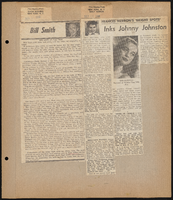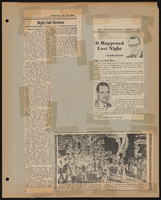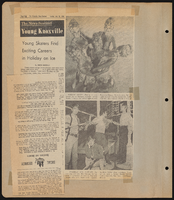Search the Special Collections and Archives Portal
Search Results
Desert Inn Country Club Newsletter Collection
Identifier
Abstract
The Desert Inn Country Club Newsletter Collection (approximately 1970-1979) contains official newsletters from the Desert Inn Country Club in Las Vegas, Nevada, as well as photographs used to create the newsletters. The photographs depict members participating in events and tournaments, and the newsletters consist mostly of black-and-white photographs that highlight club parties and tournament champions.
Archival Collection
Clark County Attorney General Files on the Howard Hughes Estate
Identifier
Abstract
The Clark County Attorney General Files on the Howard Hughes Estate (1976-1978) contain files of legal correspondence, newspaper clippings, and letters received from private individuals by the Attorney General's office regarding Howard Hughes' will after his passing in April 1976. The files were collected by Clark County District Attorney George E. Holt.
Archival Collection
Frederic Apcar Collection on the Casino de Paris Show
Identifier
Abstract
The Frederic Apcar Collection on the Casino de Paris Show (approximately 1963-1992) contains Casino de Paris programs, tent cards, and promotional information. There are also three
Archival Collection
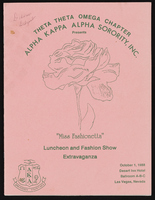
Alpha Kappa Alpha Sorority, Theta Theta Omega Chapter "Miss Fashionetta souvenier journal
Date
Archival Collection
Description
From the Alpha Kappa Alpha Sorority, Incorporated, Theta Theta Omega Chapter Records (MS-01014) -- Chapter records file.
Text
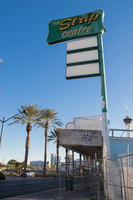
Photographs of Strip Centre sign, Las Vegas (Nev.), March 24, 2017
Date
Archival Collection
Description
Sign owner: Has been for sale since 2013
Sign details: This location has is a little shopping mall, and is called the strip centre since they are near the north end of the strip. Though this location has been up for sale since 2013.
Sign condition: 3- has had some bad weathering over the years and the paint is quite faded now.
Sign form: Blade
Sign-specific description: This sign stand on top of the building above the entrance. It is a green base that reaches the top of the sign. On the top part there is a big green steel rectangle with yellow painted words "The Strip Centre" but the word "Strip" is contained in channeled neon while the other two words are skeletal neon. Beneath this is 3 green sign boxes that would contain back lit plastic signs, but there are no signs in them currently. To the south side of the main sign there are remains of a sign that look like it used incandescent light bulbs.
Sign - type of display: Neon and plastic back lit signs.
Sign - media: Steel and plastic
Sign - non-neon treatments: Plastic back lit portion
Sign environment: This location is on the north end of the strip. It is north of the Stratosphere by a few blocks but also has some motels and wedding chapels close to it.
Sign - date of installation: Has been up since at least 2009
Sign - thematic influences: The plastic back lit portion is helpful for malls like this since they can change out which stores are within the mall relatively easily without getting a whole new sign.
Survey - research locations: Google map roadside view, attempted assessor's page but could not find it
Survey - research notes: This location was hard to find information on since it is for sale. Also I could not find information on it the assessor's page for some reason.
Surveyor: Emily Fellmer
Survey - date completed: 2017-10-01
Sign keywords: Neon; Plastic; Backlit; Steel; Pole sign; Back to back
Mixed Content
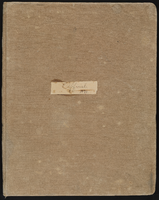
Fort Mojave Industrial School correspondence, administrative and financial information
Date
Archival Collection
Description
From the Fort Mojave Indian School Records (MS-00034). The records of the Fort Mohave Industrial School consist of two bound books of correspondence and cover the years 1890-1893. The second book contains press-copies of letters written by the school's superintendent Samuel McCowan in reply to Commissioner of Indian Affairs Thomas J. Morgan's and Assistant Commissioner R.V. Belt's letters to people doing business with the school. All letters that are direct responses include the identification number of the first letter and can therefore be matched with appropriate correspondence in the first book. While the binding is in excellent condition, many pages are missing and a good number of letters are too faint to read. Yet, the originals of these letters can be found in the National Archives and Record Services microfilmed collection titled Letters Received by the Office of Indian Affairs, Arizona Superintendency. The letters in this book relate to finance, policy implementation, annual reports, school functions, curriculum, school employment, and census data. Financial information includes: itemized accounts of all foodstuffs such as livestock and grains, and materials supplies purchase for the school such as lumber, farming implements, seeds, fruit tress, clothing, medicine, blankets, and furnishings. Also related to financial matters are requests for travel reimbursements for recruiting trips, the placing of ads in newspapers to solicit bids from suppliers, and accounts for salaries paid to school personnel. Administrative information includes annual reports of the number of students in the school. They reflect the difficulties McCowan encounters from parents in his recruiting efforts and his solutions to these problems, such as withholding food rations from families and hosting feasts at the school to lure families in. Other administrative materials include reports on the location and condition of Indian bands, which include the names of prominent band leaders and McCowan's observation of cultural rituals, his survey of the surrounding land and its suitability for farming, blue prints for the schools irrigation projects, and reports on problems between encroaching whites and resident Indians. Policy information includes reports from McCowan on his efforts to comply with Bureau of Indian Affairs educational policies and guidelines, reports on how school personnel are implementing the curriculum and the types of supplies used to accomplish this, and queries from McCowan on whether to hire students out to nearby whites as wage laborers. During scanning, the readability of the pages has been enhanced. The original manuscript has missing pages.
Text

